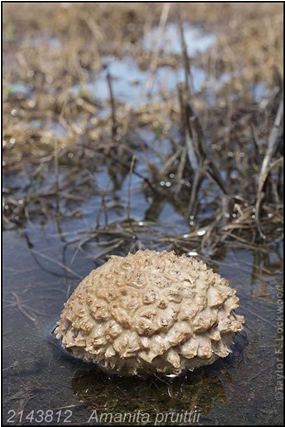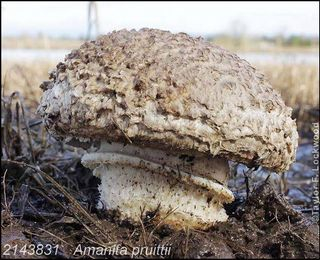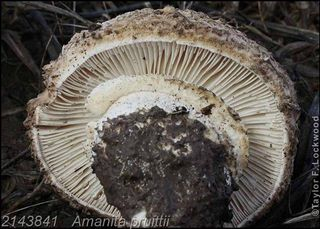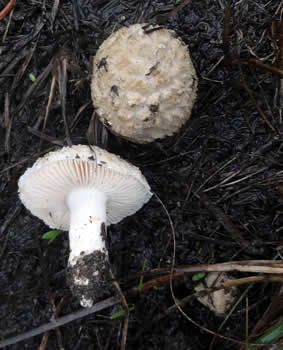Meet Amanita pruittii: Arora’s Amanita, Anonymous No More!

© Photo by Taylor Lockwood
Those of us who are passionate about all aspects of wild mushrooms are a breed apart. As mycophilic outliers to the societal norm, what better focus for our discerning attention than a mycological oddity like the newly named Amanita pruittii? This mushroom is unimposing, squat and warted, sometimes grows in standing water, and most curiously, is not found with a mycorrhizal partner!
What kind of strange Amanita is this??!
David Arora was apparently the first Western mycologist to find and document this Amanita in the Santa Cruz area in the early 1970s. He wrote about it in his classic field guide, "Mushrooms Demystified," referring to it as the "Anonymous Amanita." Although he sent collections of this unknown species to Dr. Alexander Smith in Michigan for further mycological analysis, those specimens were apparently never received.

© Photo by Taylor Lockwood
A few years later, Ben Pruitt, an 88 year old, keen-eyed naturalist and amateur mycologist in Oregon, discovered a huge fruiting of hundreds of these amanitas, in a flooded field at Fern Ridge Reservoir in the Willamette Valley, a protected Oregon State Wildlife Area as well as an Army Corps of Engineers Research Natural Area. He suspected that they might be some sort of Armillaria species, and also sent his collections to Dr. Smith. Smith determined that they were an unknown species of amanita and proposed naming them after Pruitt. But Smith never described the species.
When I attended my very first NAMA foray in 2002 at Diamond Lake, Oregon, I mentioned my ongoing interest in amanitas to other attendees. Local mycologists couldn’t wait to tell me all about a curious amanita that had recently fruited in great numbers at Fern Ridge — without a host tree in sight! This 2002 fruiting, as well as one in 1998, both of which followed prescribed burns, were apparently the first major fruitings of this non-mycorrhizal amanita since the original finds by Ben Pruitt in 1975. My interest was certainly piqued, but the local fruiting was over, and Oregon a long way from home.

© Photo by Taylor Lockwood
Fast forward to Menlo Park, San Mateo County, CA in 2007, when BAMS/FFSC member Doug Smith found what appeared to be an A. pruittii in a treeless field. Other FFSC members started to look hard for this curious mushroom, and Christian Schwarz was rewarded with a Santa Cruz sighting in 2011.
2014 was a banner year for this amanita across its range. Starting our local spate of sightings, Adam Ryzka found a solitary fruit body along a Santa Cruz city street in September 2014, followed by several observers finding it from Marshall Fields to Watsonville to West Cotati through November 2014.

© Photo by Taylor Lockwood
The most spectacular Amanita pruittii finds of 2014 were again found at Fern Ridge Reservoir during the month of October. Hundreds of fruit bodies poked their caps above standing water, in a prairie floodplain that had been burned several months prior. Taylor Lockwood obtained many wonderful photos of this phenomenon. All of these pruittii observations can be seen on MushromObserver.org.
In the Pacific Northwest, Jan Lindgren is the go-to gal for all things amanita, and she received from the late Kit Scates Barnhart the original correspondence between Ben Pruitt and Alexander Smith on Amanita pruittii. The official naming of this species was a work in progress for Jan and Rod Tulloss for decades, while other projects took precedence.
In October 2014, the name Amanita pruittii was at long last published in the online journal "Amanitaceae." Its title: "Amanita pruittii — a new, apparently saprotrophic species from US Pacific coastal states," authored by Rodham Tulloss, Janet Lindgren, David Arora, Benjamin Wolfe and Cristina Rodriguez-Caycedo.
Other than its peculiar fruiting habits, this is a rather unprepossessing mushroom, with a dirty white cap, a squat form, and a universal veil (UV) that breaks into warts on the cap, and forms fibrils or squamules on the pointed stipe; all of these UV elements can disappear with age. Amanita pruittii often discolors brown or reddish with age, especially when growing in wet conditions. Like all amanitas, A. pruittii has whitish gills and white spores in mass, and like other members of Amanita section Lepidella, those spores turn blue upon the application of the iodine-based Melzer’s solution.

Amanita pruittii, Marshall Fields, UC Santa Cruz campus
2014 © Photo by Thomas Laxton
Pruittii can have a variety of odors, from indistinct to earthy, potatoes to brine, and becomes unpleasant smelling in age. Its taste is not distinctive when raw, but is bitter and unpleasant when cooked. Despite this, Ben Pruitt tried four slices from his original collections, and reported no adverse effects. However, eating any member of Amanita section Lepidella is not recommended, since this group is often difficult to identify to species, and contains seriously toxic species like Amanita smithiana.
Heads-up, California and PNW mushroom hunters! Keep your keen eyes peeled for more fruitings of this very curious amanita. It can grow singly or gregariously, and under the right conditions, by the hundreds, especially following a burn. Look for it in lawns, wet meadows and pastures, with poor, exposed soils and even in street tree wells! It most commonly fruits in the fall months, but can also fruit into March and as late as June in irrigated landscapes. It sometimes grows alongside various species of Agaricus, and can be mistaken for that genus.
When you next see a "commonplace" field of white mushrooms, assume nothing and check those gills! Who knows, you might be the next lucky person to find this very curious, non-mycorrhizal amanita, Amanita pruittii: Arora’s "Anonymous Amanita" no longer!
Debbie Viess aka Amanitarita
This page was first published on the website of the Fungus Federation of Santa Cruz. © Debbie Viess, June 2015

 back to top
back to top